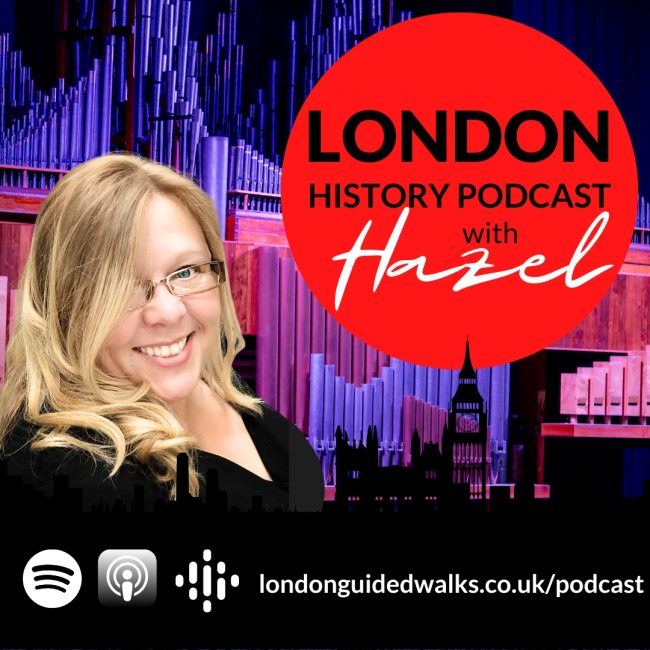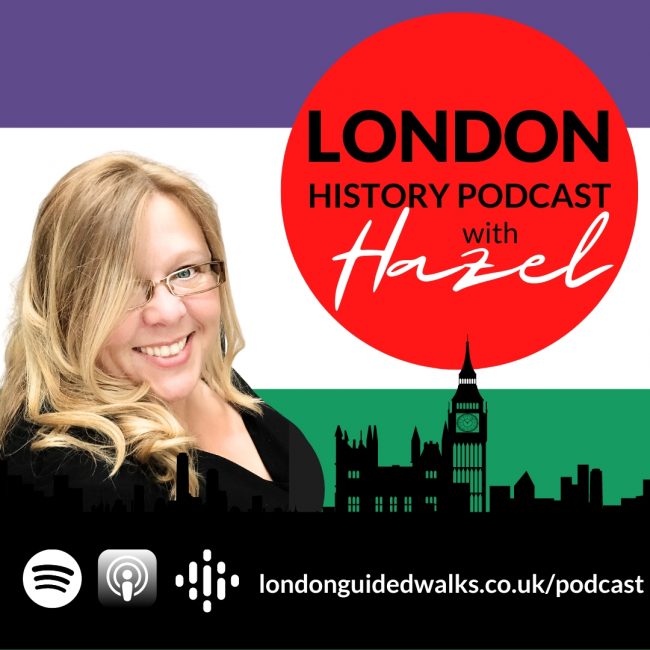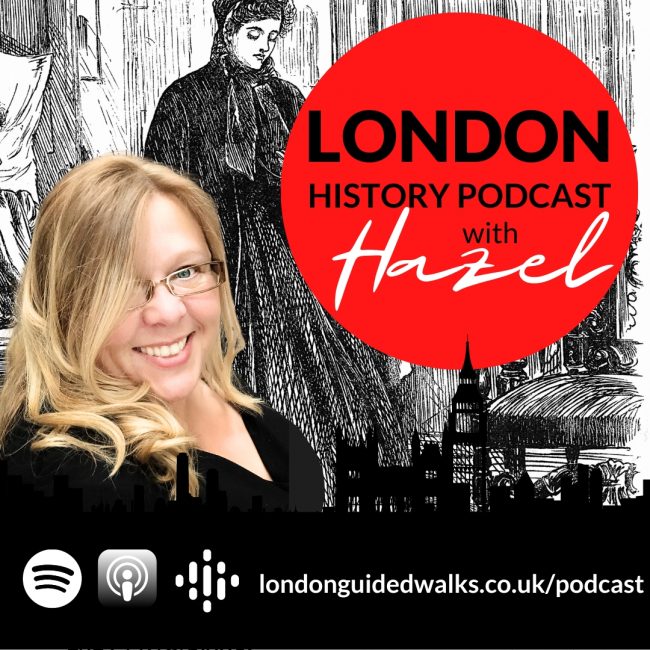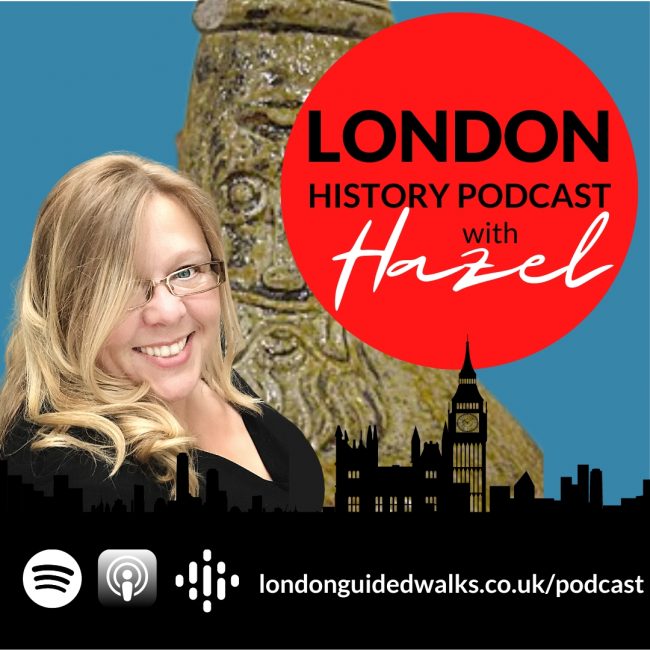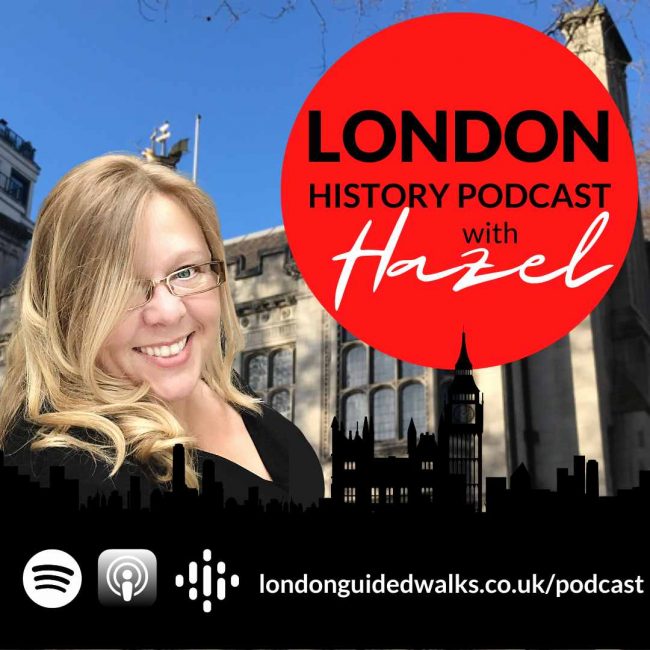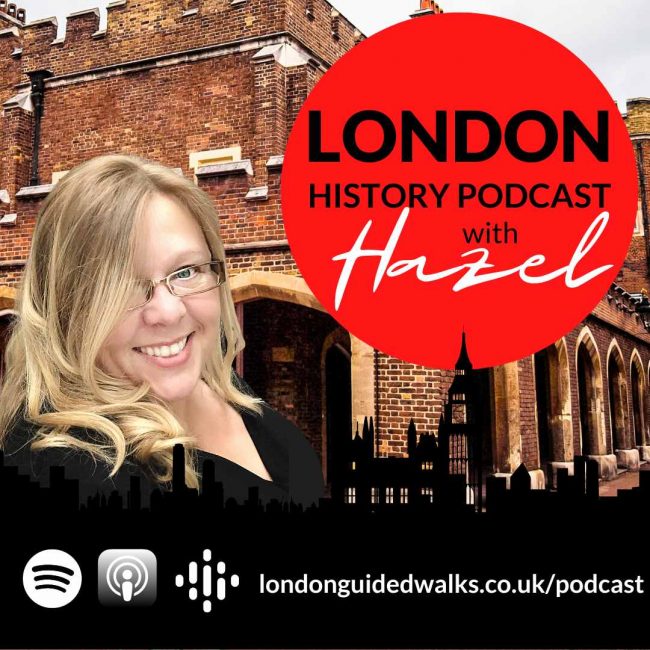What do Benjamin Franklin, John Milton and Samuel Johnson have in common? Find out on our latest episode where Hazel talks about the street Little Britain in the City of London.
London Guided Walks » Episode 30: Quirky Street Names – Little Britain
Episode 30: Quirky Street Names – Little Britain
Quirky Street Names – Little Britain
Show Notes:
 Hazel Baker: Hello and welcome to London Guided Walks London History podcast. In the coming episodes, we will be sharing our love and passion for London, its people, places and history in an espresso shot with a splash of personality. For those of you who don’t know me, I am Hazel Baker, founder of London Guided Walks, providing guided walks and private tours to Londoners and visitors alike.
Hazel Baker: Hello and welcome to London Guided Walks London History podcast. In the coming episodes, we will be sharing our love and passion for London, its people, places and history in an espresso shot with a splash of personality. For those of you who don’t know me, I am Hazel Baker, founder of London Guided Walks, providing guided walks and private tours to Londoners and visitors alike.
One of the most popular things that I get asked and a lot of people are interested in are the street names and how they got their name. And we have some really strange ones in London. So I put it to our followers on social media, Instagram, Twitter, and Facebook, and asked them what street name they would like covering in this podcast. The most popular response was Little Britain, as upvoted by Julie, Gary, and Gita. So this one is for you.
Little Britain is a street in the city of London and measures approximately 285m in length. It crosses postcodes of EC1A4 and also EC1A7. For those of you who aren’t familiar with London postcodes, the EC stands for Eastern Central, and it’s a group of districts in central London, city of London, and also parts of the boroughs of Islington, Hackney, Tower Hamlets, Camden, and Westminster. The average house in Little Britain sells for £903,129 and 17p.
And as unique as it sounds, there are in fact, three other streets named Little Britain in Great Britain. It’s an interesting small neighbourhood consisting of a cluster of evocative narrow streets and courts. It’s a narrow winding street near Smithfield market. And it’s recently had a new facelift really with all the development work around due to St. Bartholomew’s Hospital. It’s in oldest Gatewood and Farrington ward without, so that is the same area that we do Bleeding Hearts and Body Parts Tour, and also our Heretics and Horrors. It’s a fantastically, wonderful, historic area of town.
And the first mention of Little Britain street is in 1600. However, how it’s got its name may give you a little bit of a hint of what it was named previously. As with the ever-changing London, it has had several names prior to that. One at Bertone St. at 1329, also Britten street, Petty Britane, and also Petty Brittania 1561, Lyttel Britain, and then Little Britania afterwards. So there’s quite a few different variations of something we know little and we also have Britane or Britten, and this is taken its name from the dukes of Briton, who are lodged there. Now this is referring to the dukes of Britanny. And they were supposed to have had their mansion and garden on this street extending to the town ditch. Cause we are right on the edge of the city of London and you’ve got the river fleet right there. So there would have been a large house and gardens and also it is shown in a 1570 map actually by Braun and Hogenburg, and that’s might actually be the house that people are linking with the dukes of Brittany.
Also the Northern portion of Little Britain from St. Bartholomew’s Hospital up to west Smithfield. And that was formerly known as Duke street, hint to Dukes of Brittany. So Little Britain and Duke Street. And we can see from the registers, from the rate collector’s books and also from the half tax accounts. So these are basically the taxes for having a fireplace. There were lots of little areas known as little around, including little Bartholomew clothes. And also we had Petty Wales, which you’d assume was derived from the houses being occupied before the suppression by a small colony of Welshman. And so Petty Wales. We’ve also got a little Britain linking there. And there was a Petty Wales in the parish of all Hallows Barking as well. And another one by the custom house in lower Thames St. So this name little or petty seems to indicate little pockets of migrant communities.
It’s hard to talk about the history of one particular street when you need to look at how it’s linked with the rest of the area. There was one particular event that happened nationally. But also happened arguably more intensively in London in terms of the impact was the dissolution of the monasteries during the reign of Henry VIII, then it was in 1539 that St Bart’s became victim to this. Now a number of monastic churches were acquired by local people as Paris churches. Some monastic hospitals, such as those for lepers at St. Charles and St. James is they closed for good, but others such as St. Bartholomew’s and also St. Thomas’s continued as secular institutions even to this day. And land, which once belonged to the church, now belongs to the king. And in a ground to serve Richard Rich in 1544.
The primary of St. Bartholomew, the boundaries of great St. Bartholomew close are set out and both on me close, which is all part of a little Britain is regarded as a parish by itself. And it’s well, it’s fallen to precinct and the inhabitants enjoyed special privileges such as freedom from arrest. And also privileges originally granted to the ancient monastic foundation by Henry I.
As London grew, the fashionable moved to the west and creating an opportunity for these areas to create a new identity. And this area was very busy and famous, full booksellers, but the booksellers eventually moved to Newgate St. and down to Paternoster row and St Paul’s churchyard. And even though it may be a relatively small street, it isn’t without its big names. For in 1712, Samuel Johnson, but he was only two and a half years old at the time, he first visited London from Lichfield, his hometown, with his mother. And he and his mother lodged at a booksellers here in Little Britain. Maybe the bookseller knew Samuel Johnson’s father, Michael, as he was a bookseller in Lichfield. And it wasn’t a pleasure trip. Johnson was one of 200 individuals to be given the Royal touch by Queen Anne and the Royal touch was an ancient, magical ceremony designed to treat scrofula.
And Johnson had developed scrofula at age about two years old from infective cows milk. And this called many problems throughout his childhood and his eyes were severely affected. This is what they believe. So the treatment, he’d already gone through, he’s 2 and a half years old. They had made an issue in his left arm, which was an incision where that was kept open with a small foreign body, such as a P and this form of therapy, it was designed to drain away any evil humours that were inside the body. None of that worked. And so Samuel, 2 and a half years old comes and stays in Little Britain as he’s waiting to be given the Royal touch by Queen Anne.
Johnson was examined by a court physician, blessed by the court chaplains, and presented with a golden amulet by Queen Anne herself. And he wore this amulet around his neck forevermore. Unsurprisingly Johnson’s scrofula were not cured. And the scars on his face and neck were visible for the rest of his life, which was upsetting for him, actually, he read to the material very close to his face. And Mr. Thrill, his friend, noted that Johnson wigs later on in his life and his sixties his wigs were scorched from readings too close to a candle and he was afraid that Johnson might actually burn himself while reading in bed. And he really seemed to hate the portrait that suggests you or Dr. Reynolds does of him where he’s intently reading a book and he thought that it was actually showing or highlighting his week on the big name residents and Little Britain include John Milton, the English poet and scholar.
He lived on Little Britain briefly in 1662 and also in 1711. And he wrote about the area because he lived in it and we used some of that in our Episode 6: Lost London Hockley in the Hole episode, if you haven’t heard that have a listen and see how he describes the area back in the 18th century.
Benjamin Franklin was another big name having lived on Little Britain. He arrived in London on Christmas Eve, 1724, with the expectation of being able to buy the state of the art printing press and returned to Philadelphia and set it up in business with Sir William Keith. However, it soon became obvious that all of Keith’s promises were frankly worthless and Franklin found himself stranded in London. And that could have been a really serious problem for anybody that was unskilled. And also unfamiliar in this large metropolis. Well, of course he had sealed letters of both introductions and credits and he was able to find work at Palmers. And that was a printing firm house in the former lady, chapel of St. Bartholomew the Great. And it was with his friend, James Ralph, they took up lodgings. So the teenage Benjamin Franklin’s first ever address was in Little Britain. It was close to his work and it also held a greatest significance as Little Britain at the time was a really important centre of printing and publishing.
And you could argue that it was a spiritual home for Franklin. It’s where Samuel Buckley had printed The Daily Current, which was London’s first daily newspaper in 1702, and was also the inspiration for the new England current where Benjamin Franklin had served his first apprenticeship under the editor real eye of his elder brother, James. Samuel Buckley was also the publisher of an even more important journal, the first version of The Spectator. And this had an extraordinary influence on the youthful Benjamin Franklin, and it’s all happening around him. This is what’s so excited, he was right in the middle of it all.
Little Britain is now divided into three. So remember I mentioned the north part once being called Duke Street. There’s no sign of Alison or Buckley, let alone Franklin here. And the streets has changed completely because of this ongoing building work for St. Bartholomew’s Hospital. And it looks great now, but it’s kind of lost this atmosphere. So it’s great to put the history together.
But of course it’s not just those big names. Oh no. Also it was where Charles Wesley’s evangelical conversion took place in 1738. And it’s also where Charles Dickens writes in great expectations in 1860 with The Solicitor Jaggers. This is where he has his office, here in Little Britain. Booksellers had dominated the area from the mid 16th century, and that was then followed by Goldsmiths and trading of cloth. With cloth fairs around the corner from the mid 18th century to the 20th centuries.
Little Britain is also mentioned in The Sketchbook, which is the sketchbook of Jeffrey Cryan which are 34 essays and short stories written by American author, Washington Irving. And he came over to London to try and help his family out. And he puts these essays, the British version of these essays published in 1819 and 1820. And little Britain is there. Oh yes. In July, 1820, the English version of volume 2, Cryan describes the history, provided to him by the super uninitiated tradesmen, which describes the heart of old London in the centre of the great city of London lies a small neighbourhood consisting of a cluster of narrow streets and courts of very venerable and debilitated houses, which goes by the name of Little Britain. Christ Church School and St. Bartholomew’s Hospital bounded on the west Smithfield and long lane on the north. Oldest gate street, like an arm of the seed, divides it from the Eastern part of the city, whilst the yawning Gulf of bull and mouth street separates it from Butcher lane and the regions of Newgate. Over this little territory that’s bounded and designated the great dome of St. Paul’s swelling above the intervening houses of Paternoster row, arm, and corner and Ave Maria Lane looks down with an air of motherly protection.
So in 1820, it sounds like it’s a bustling community. And then in Robson’s directory in 1832, it’s still looking pretty much the same. Don’t forget it’s a short street and yet it has four pubs. Whitehall’s, Rose and Crown, Swan and Horseshoe, and, and.
And then 10 years later, we have another directory, so 1842. And this time there’s a little bit more detail in some of the trades that are going on in the area. So we still have the full pubs, not surprising there, but we have only one bookseller now. So an area that was filled with booksellers before, only one is remaining at number 16. And then for food and essentials, you have a grocer and cheesemonger, we have a baker, a tobacconist, and a greengrocers here. Essentials are right there, but then this is where the infiltration comes in of, well, those from the clothing trade.
So we had Smith and sons, leather workers. We have Lyle who was a boot maker. We have Ms. James, there was a milliner. Banfield a tailor. Another boot maker at 46 and yeah, another tailor at 71. And in between those houses, you had skilled workers. So this included a lady who did fur and art flower as a wholesaler, engravers, leather sellers, silver and tin workers, gold and silver wire makers, musical instrument maker, teapot handle maker. I wonder how many we’d need of those nowadays? And also a guilt joule.
The difference here between the street is going from a fashionable housing gardens to them, booksellers, where of course that’d be also printing in the area and now moving to a place where people make things. They’re making boots, they’re making clothes, they’re making leather works. They’re making beautiful jewellery. They’re making tea pot handles and musical instruments. All highly skilled work, all very physical trades, something we don’t see very much of nowadays.
And this was the world that Charles Dickens had seen. Don’t forget, we’re talking about 1830 to 1842. Has anything really changed from then to when he is writing? Great expectations in 1860. As this is where he sets the solicitors office of Mr. Jagger on which PIP needs to visit quite frequently.
So who knows what little Britain will be like in the future? At the moment it’s got brand new spaces for shops, all empty, ready for the new tenants. And if you’re in the area, why don’t you have a little walk round, maybe take a few photos and tag us on social media. It’d be lovely to see you and your London exploration.
That’s all we’ve got time for now, but hopefully you’ve enjoyed it. And if you have then, why not click on those five stars or even better? Write us a review. Thanks very much. And I’ll see you next week.

